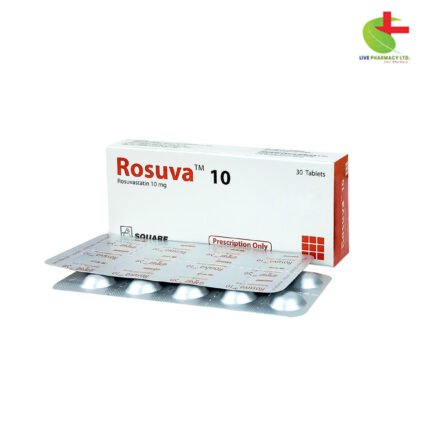Rosuva 20
301.00৳ Strip
- Rosuvastatin, marketed as Rosuva, is a potent statin medication.
- It effectively lowers cholesterol levels in the blood.
- Used to treat conditions like familial and non-familial hypercholesterolemia, mixed dyslipidemia.
- Aids in preventing cardiovascular disease by inhibiting cholesterol synthesis and enhancing LDL receptor activity.
- Well-tolerated and often combined with lifestyle modifications for optimal management of lipid disorders.
 Brand
Brand
|
Square Pharmaceuticals PLC |
|---|---|
 Generics
Generics
|
Rosuvastatin Calcium |
Indications
Rosuvastatin is recommended for treating Heterozygous Hypercholesterolemia (both familial and non-familial), Homozygous Hypercholesterolemia (familial), Mixed Dyslipidemia (Fredrickson Type IIa and IIb), and for primary prevention of cardiovascular disease.
Pharmacology
Rosuvastatin functions as a selective and competitive inhibitor of HMG-CoA reductase, the key enzyme in converting 3-hydroxy-3-methyl glutaryl coenzyme A to mevalonate, a precursor of cholesterol. Its lipid-modifying effects occur through two mechanisms: increasing the number of hepatic LDL receptors to enhance LDL uptake and catabolism, and inhibiting hepatic synthesis of VLDL, thereby reducing the total number of VLDL and LDL particles.
Dosage
Recommended dose range is 5-40 mg once daily. Consider 40 mg dose only for patients not achieving LDL-C goal with 20 mg. For HoFH, initiate with a 20 mg/day dose. Pediatric patients with HeFH should receive 5-10 mg/day for ages 8 to less than 10 years, and 5-20 mg/day for ages 10 to 17 years. Pediatric patients with HoFH should start with 20 mg/day for ages 7 to 17 years.
Administration
Rosuvastatin can be taken with or without food, at any time of the day.
Interaction
Notable drug interactions include: Cyclosporine (limit Rosuvastatin dose to 5 mg once daily when combined), Gemfibrosil (avoid combination; if used together, limit Rosuvastatin dose to 10 mg once daily), Lopinavir/Ritonavir or atazanavir/ritonavir (limit Rosuvastatin dose to 10 mg once daily when combined), Coumarin anticoagulants (monitor INR closely), and concomitant lipid-lowering therapies (exercise caution).
Contraindications
Rosuvastatin is contraindicated if there is a known hypersensitivity to its components, liver disease is present, including unexplained persistent elevations in hepatic transaminase levels, or if the patient is pregnant, planning pregnancy, or nursing.
Side Effects
Rosuvastatin is generally well tolerated, with the most common adverse events being headache, myalgia, constipation, asthenia, abdominal pain, and nausea.
Pregnancy & Lactation
The safety of Rosuvastatin in pregnant women has not been established. Its excretion in human milk remains unknown.
Precautions & Warnings
Be cautious of skeletal muscle effects, especially with higher doses, advanced age, hypothyroidism, renal impairment, or concomitant use of certain medications. Monitor liver enzyme levels before and during treatment.
Use in Special Populations
The safety and effectiveness of Rosuvastatin in pediatric patients have not been established.
Therapeutic Class
Rosuvastatin belongs to the class of Other Anti-anginal & Anti-ischaemic drugs, Statins.
Storage Conditions
Store below 30°C, protected from light and moisture, and keep out of reach of children.
Chemical Structure
Molecular Formula: C22H28FN3O6S, Chemical Structure: Rosuvastatin Calcium’s chemical structure.
Common Questions about Rosuvastatin 20 mg Tablet
Various questions regarding its uses, side effects, duration of treatment, dietary considerations, and potential interactions are addressed.
Quick Tips
Rosuvastatin 20 mg Tablet is effective in treating high cholesterol when combined with exercise and a low-fat diet. It is generally safe but may cause gastrointestinal discomfort; taking it with food can help. Report any unusual fatigue or muscle-related symptoms to your doctor promptly. Regular liver function monitoring is advised during treatment, especially for patients with pre-existing conditions. Avoid alcohol consumption during treatment, as it may exacerbate liver issues and increase triglyceride levels.













Reviews
There are no reviews yet.